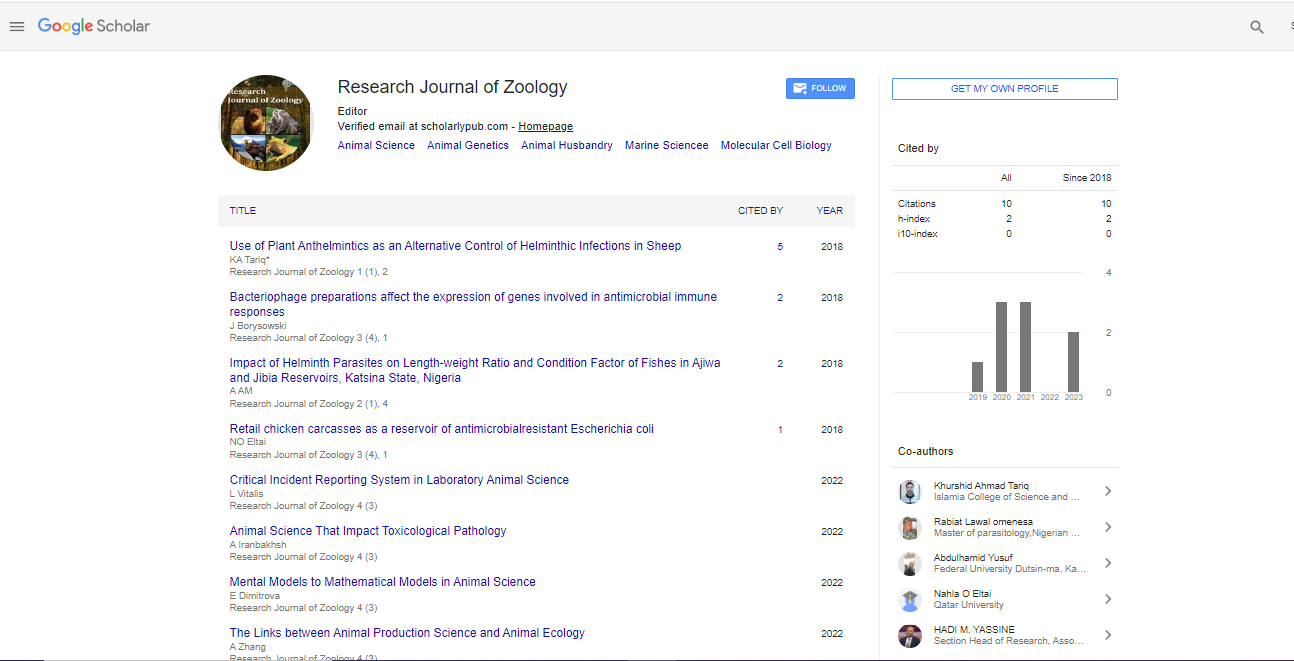Perspective, Res J Zool Vol: 5 Issue: 4
Exploring Soil Zoology and its Ecological Significance
Mirane Bulente*
1Department of Zoology, Humboldt University, Berlin, Germany
*Corresponding Author: Mirane Bulente,
Department of Zoology, Humboldt
University, Berlin, Germany
E-mail: bulente.mir@gmail.com
Received date: 21 November, 2023, Manuscript No. RJZ-24-128144;
Editor assigned date: 23 November, 2023, PreQC No. RJZ-24-128144 (PQ);
Reviewed date: 07 December, 2023, QC No. RJZ-24-128144;
Revised date: 15 December, 2023, Manuscript No. RJZ-24-128144 (R);
Published date: 22 December, 2023, DOI: 10.4172/RJZ.1000092.
Citation: Bulente M (2023) Exploring Soil Zoology and its Ecological Significance. Res J Zool 5:4.
Description
Soil, generally considered as the silent and simple foundation under the soles, harbors a vibrant and complex ecosystem that plays an essential role in sustaining life on Earth. Soil zoology plays an essential role in discovering this hidden world; it is a branch of biology dedicated to the study of animal life within the soil.
Diversity of soil fauna
Soil fauna encompass a wide range of array organisms, ranging from microscopic bacteria and fungi to larger invertebrates such as mites, springtails, nematodes, and earthworms. Each of these organisms plays a specific role in the difficult web of interactions within the soil ecosystem at the microscopic level, bacteria and fungi form the foundation of the soil food web. Bacteria, with their role in nutrient cycling and decomposition, contribute to the breakdown of organic matter. Fungi, including mycorrhizal fungi form symbiotic relationships with plant roots, enhancing nutrient metabolism and stimulate plant growth. Mites and springtails engineers of the soil mites and springtails are among the macroscopic soil fauna that contribute to the physical structure of the soil. These small arthropods engage in the breakdown of organic matter, facilitating nutrient release, and their movements oxygenate the soil, stimulating water infiltration and root growth. Nematodes, microscopic roundworms, exhibit diverse feeding techniques. Some are predators, hunting bacteria and other nematodes, while others are decomposers, contributing to the breakdown of organic material. Plant-parasitic nematodes, however, pose challenges to agriculture by affecting crop health. Earthworms, frequently considered ecosystem engineers, play a significant role in soil structure and nutrient cycling. Their burrowing activities improve soil aeration and drainage, and the organic matter they consume is transformed into nutrient-rich casts that enhance soil fertility.
Ecological interactions in the soil
Soil zoology creates a tapestry of ecological interactions that shape the dynamics of the soil ecosystem. These interactions contribute to nutrient cycling, soil structure maintenance, and the overall health of terrestrial ecosystems. Soil fauna, especially microorganisms, mites, springtails, and nematodes, are integral to the decomposition of organic matter. Through a process known as mineralization, organic substances are broken down into inorganic forms, releasing nutrients such as nitrogen, phosphorus, and potassium into the soil. This nutrient cycling is fundamental for plant growth and ecosystem sustainability. Mycorrhizal fungi develop symbiotic interactions with the roots of the majority of plants. In exchange for sugars produced by the plant through photosynthesis, these fungi enhance the plant's absorption of nutrients, particularly phosphorus and nitrogen. This mutualistic association is essential for the health and productivity of many terrestrial plants. Predatory interactions within the soil ecosystem contribute to the regulation of populations. Predatory nematodes, mites, and other soil invertebrate’s help to control the populations of bacteria, fungi, and other small organisms, maintaining a balance within the soil community. Earthworms, with their burrowing activities, are important contributors to soil structure modification. Their tunnels enhance water infiltration, reduce soil compaction, and create an appropriate atmosphere for root growth. The physical alterations made by earthworms have far-reaching effects on the overall health of the soil.
Soil zoology in agriculture
Understanding the role of soil fauna is essential in the world of agriculture. Soil zoology provides insights into sustainable practices that harness the natural processes occurring beneath the soil surface.
Biological pest control: Predatory soil organisms, including certain mites and nematodes, contribute to biological pest control. By preying on harmful pests, these natural predators help to reduce the need for chemical pesticides in agriculture, promoting environmentally pest management.
Soil fertility management: Soil zoology contributes to soil fertility management by elucidating the processes of nutrient cycling. Practices that enhance the abundance and diversity of soil fauna, such as cover cropping and organic matter incorporation, can improve soil fertility naturally.
Earthworm-assisted vermicomposting: Earthworms are central to the practice of vermicomposting; it is a sustainable method of organic waste decomposition. Earthworms consume organic material and convert it into nutrient-rich casts, creating a valuable soil amendment that enhances plant growth and soil fertility.
 Spanish
Spanish  Chinese
Chinese  Russian
Russian  German
German  French
French  Japanese
Japanese  Portuguese
Portuguese  Hindi
Hindi 
